Fuses and Relays
A vehicle’s electrical system is protected from electrical overload damage by fuses.
This vehicle has 2 fuse panels, one located in the driver’s side panel bolster, the other in the engine compartment near the battery.
If any of your vehicle’s lights, accessories, or controls do not work, check the appropriate circuit fuse. If a fuse has blown, the element inside the fuse will be melted.
If the electrical system does not work, first check the driver’s side fuse panel.
Before replacing a blown fuse, disconnect the negative battery cable.
Always replace a blown fuse with one of the same rating.
If the replacement fuse blows, this indicates an electrical problem. Avoid using the system involved and we recommend that you consult with an authorized HYUNDAI dealer immediately.
Three kinds of fuses are used: blade type for lower amperage rating, cartridge type and multi fuse for higher amperage ratings.
This vehicle has 2 fuse panels, one located in the driver’s side panel bolster, the other in the engine compartment near the battery.
If any of your vehicle’s lights, accessories, or controls do not work, check the appropriate circuit fuse. If a fuse has blown, the element inside the fuse will be melted.
If the electrical system does not work, first check the driver’s side fuse panel.
Before replacing a blown fuse, disconnect the negative battery cable.
Always replace a blown fuse with one of the same rating.
If the replacement fuse blows, this indicates an electrical problem. Avoid using the system involved and we recommend that you consult with an authorized HYUNDAI dealer immediately.
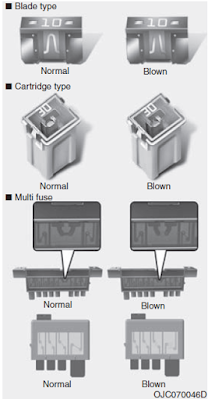 |
| Fuses Types - Blown fuse, Normal fuse |
WARNING - Fuse replacement
• Never replace a fuse with anything but another fuse of the same rating.
• A higher capacity fuse could cause damage and possibly a fire.
• Never install a wire or aluminum foil instead of the proper fuse - even as a temporary repair. It may cause extensive wiring damage and a possible fire.
CAUTION
Do not use a screwdriver or any other metal object to remove fuses because it may cause a short circuit and damage the system.
CAUTION
• When replacing a blown fuse or relay with a new one, make sure the new fuse or relay fits tightly into the clips. The incomplete fastening fuse or relay may cause the vehicle wiring and electric systems damage and a possible fire.
• Do not remove fuses, relays and terminals fastened with bolts or nuts. The fuses, relays and terminals may be fastened incompletely, and it may cause a possible fire. If fuses, relays and terminals fastened with bolts or nuts are blown, consult with an authorized HYUNDAI dealer.
• Do not input any other objects except fuses or relays into fuse/relay terminals such as a driver or wiring. It may cause contact failure and system malfunction.
• When replacing a blown fuse or relay with a new one, make sure the new fuse or relay fits tightly into the clips. The incomplete fastening fuse or relay may cause the vehicle wiring and electric systems damage and a possible fire.
• Do not remove fuses, relays and terminals fastened with bolts or nuts. The fuses, relays and terminals may be fastened incompletely, and it may cause a possible fire. If fuses, relays and terminals fastened with bolts or nuts are blown, consult with an authorized HYUNDAI dealer.
• Do not input any other objects except fuses or relays into fuse/relay terminals such as a driver or wiring. It may cause contact failure and system malfunction.
 |
| Instrument panel fuse replacement |
Instrument panel fuse replacement
1. Turn the ignition switch and all other switches off.
2. Open the fuse panel cover.
3. Pull the suspected fuse straight out. Use the removal tool (Fuse Puller) provided in the engine compartment fuse panel.
4. Check the removed fuse; replace it if it is blown.
5. Push in a new fuse of the same rating, and make sure it fits tightly in the clips. If it fits loosely, we recommend that you consult with an authorized HYUNDAI dealer.
If you do not have a spare, use a fuse of the same rating from a circuit you may not need for operating the vehicle, such as the cigarette lighter fuse. If the electrical components do not work and the fuses are OK, check the fuse panel in the engine compartment. If a fuse is blown, it must be replaced.
Fuse switch
 |
| Fuse switch |
Always, put the mode switch at the ON position.
If you move the switch to the OFF position, some items such as audio and digital clock must be reset and transmitter (or smart key) may not work properly.
CAUTION
Always place the fuse switch in the ON position while driving the vehicle.
Always place the fuse switch in the ON position while driving the vehicle.
Engine compartment panel fuse replacement
1. Turn the ignition switch and all other switches off.
2. Remove the fuse box cover by pressing the tab and pulling up the cover.
3. Check the removed fuse; replace it if it is blown. To remove or insert the fuse, use the fuse puller in the engine compartment fuse panel.
4. Push in a new fuse of the same rating, and make sure it fits tightly in the clips. If it fits loosely, we recommend that you consult with an authorized HYUNDAI dealer.
2. Remove the fuse box cover by pressing the tab and pulling up the cover.
3. Check the removed fuse; replace it if it is blown. To remove or insert the fuse, use the fuse puller in the engine compartment fuse panel.
4. Push in a new fuse of the same rating, and make sure it fits tightly in the clips. If it fits loosely, we recommend that you consult with an authorized HYUNDAI dealer.
If the main fuse is blown, it must be removed as follows:
1. Disconnect the negative battery cable.
1. Disconnect the negative battery cable.
2. Remove the nuts shown in the picture above.
3. Replace the fuse with a new one of the same rating.
4. Reinstall in the reverse order of removal.
3. Replace the fuse with a new one of the same rating.
4. Reinstall in the reverse order of removal.
Multi fuse
 |
| Multi fuse |
If the multi fuse is blown, it must be removed as follows:
1. Remove the fuse panel in the engine compartment.
2. Remove the nuts shown in the picture above.
3. Replace the fuse with a new one of the same rating.
4. Reinstall in the reverse order of removal.
✽ NOTICE
If the main or multi fuse is blown, we recommend that you consult with an authorized HYUNDAI dealer.
Fuse/relay panel description
Inner fuse panel
Inside the fuse/relay panel covers, you can find the fuse/relay label describing fuse/relay name and capacity.
NOTICE
Not all fuse panel descriptions in this manual may be applicable to your vehicle.
It is accurate at the time of printing. When you inspect the fuse panel in your vehicle, refer to the fuse panel label.
Not all fuse panel descriptions in this manual may be applicable to your vehicle.
It is accurate at the time of printing. When you inspect the fuse panel in your vehicle, refer to the fuse panel label.
 |
| Inner fuse panel |
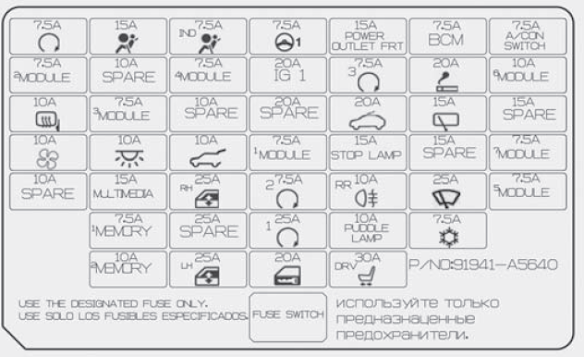 | |
| Inner fuse panel Diagram |
Instrument panel (Driver’s side fuse panel)
Engine compartment fuse panel
 |
| Engine compartment Fuse Box Location |
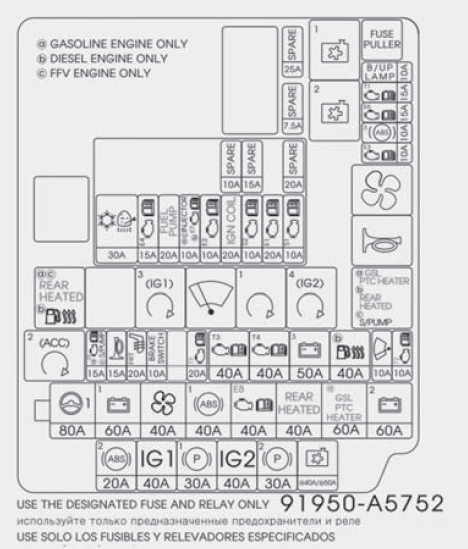 |
| Engine compartment fuse panel Diagram |
 |
| Engine compartment fuse Specification Chart |
Engine compartment fuse panel (Diesel engine only)
 |
| Engine compartment fuse panel (Diesel engine only) |
PTC 1 .. 50A .. PTC 1 Relay
PTC 2 .. 50A .. PTC 2 Relay
PTC 3 .. 50A .. PTC 3 Relay


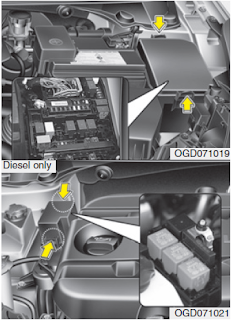


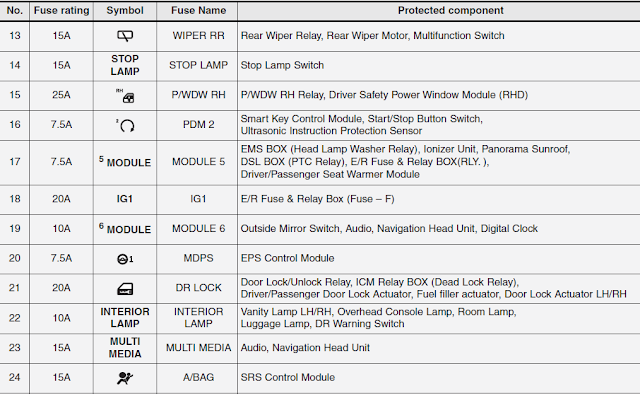

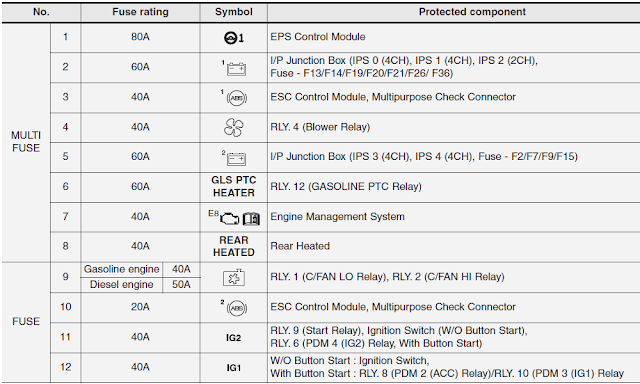
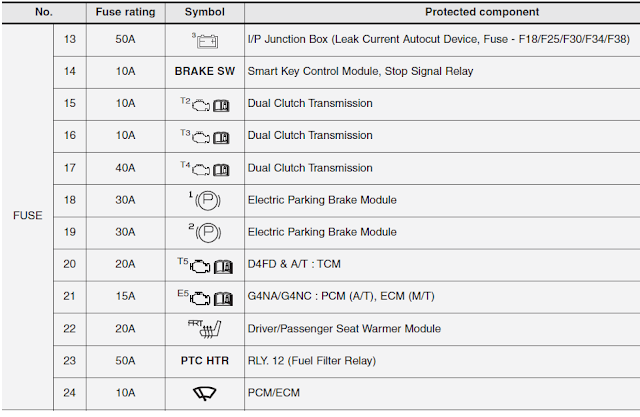


No comments:
Post a Comment